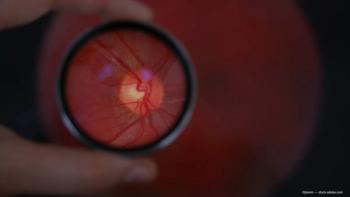
Redefining glaucoma care: Where innovation meets clinical insight
Ophthalmologists discuss how advanced imaging, MIGS, and home monitoring are reshaping decision-making in complex glaucoma cases.
Glaucoma continues to challenge clinicians as one of the world’s leading causes of irreversible blindness, demanding ever-more sophisticated tools for early detection, monitoring, and treatment. From minimally invasive surgical options to AI-driven imaging analysis and emerging home-based technologies, the field is rapidly evolving. To explore how these innovations are reshaping clinical decision-making and patient care, the Eye Care Network caught up with the following ophthalmologists for their insights on surgical strategy, diagnostic advances, and the next wave of therapeutic possibilities.
- Rachel Simpson, MD, residency program director, vice chair of education, and assistant professor of ophthalmology with the John A. Moran Eye Center at the University of Utah in Salt Lake City, UT.
- Allison Soneru, MD, glaucoma service, Mass Eye and Ear; instructor, Ophthalmology, Harvard Medical School; associate director, Anterior Segment Fellowship, Mass Eye and Ear; and glaucoma surgeon, Jamaica Plain Veterans Affairs Hospital, Boston VA, in Boston, MA.
Note: Transcript edited lightly for clarity and length.
How do you decide between traditional surgery and MIGS for complex glaucoma cases?
Simpson: There are a lot of factors that go into the decision of whether to do minimally invasive glaucoma surgery (MIGS) or more traditional glaucoma surgery. I usually start by reflecting on why we are doing surgery in the first place. If they have a visually significant cataract, then MIGS is a very easy decision. In those who do not have a built-in reason for surgery, the decision making is a bit more complex. I try and start by considering the severity of glaucoma and their disease stability. In general, I like to use MIGS + cataract surgery for my ocular hypertensives and my mild to moderate glaucoma patients. I will do phaco + MIGS even if the cataract is not visually significant if the patient is slowly progressing and the IOP is slightly above goal, or if patient is on maximum tolerated therapy and needs additional intervention but their disease is relatively mild. I prefer traditional glaucoma surgery for patients who are progressing quickly, those who have IOP significantly above goal, or who have severe disease. If I believe the IOP needs to be very low (12 mm Hg or less), I strongly believe the only option is traditional glaucoma surgery for most patients.
Finally, it is important to consider the patient, their overall health ,and how burdensome a major surgery will be. There are many patients whose vision can outlast their lifespan even if they are slowly progressing, so I always try and have a conversation with patients about their overall health, especially when considering major surgery.
Soneru: The severity of glaucoma is one major factor, and whether they are getting simultaneous cataract surgery. Another major factor is whether the glaucoma is progressing, because if I am trying to stop progression, I am likely to choose a more aggressive plan than if I am trying to decrease drop burden in a patient with stable disease. In addition to these disease-driven factors, there are patient-driven factors: some patients often have various social challenges that prevent them from regularly following up or being able to take postop medications reliably. That influences the chance of success for something like a trabeculectomy, which requires precise postop management and often frequent postop visits. Patients also have different tolerances for risk, and so that is always a discussion I have with the patient as well.
What innovations in imaging or tonometry aid early glaucoma detection?
Simpson: We are moving closer and closer to a place where we will be able to have 24/7 eye pressure monitoring. There is a growing body of evidence to suggest that we are not fully capturing the pressure fluctuations that many [patients with] glaucoma experience. The ability to monitor pressure fluctuations in real time will be a significant tool in tailoring glaucoma treatments to individual patients. For now, the iCare home [tonometer] is a great resource to use for home pressure monitoring.
Soneru: Detecting glaucoma earlier in my mind is currently about finding a way to more effectively detect glaucoma and its progression in the (high volume of) data we have access to already. We get a myriad of data from visual fields, optical coherence tomography, ganglion cell complex scans, central corneal thickness, corneal hysteresis, and of course, the intraocular pressure and examination. Machine-learning models have been developed that can more accurately predict glaucoma progression compared to our conventional statistical approaches.
A level up from that are newer stacked weight-based meta-learning frameworks to synthesize multiple machine learning models to improve accuracy.1 Cluster testing—performing a cluster of multiple visual field tests at a time, 6 months apart—is another recently proposed method to detect progression earlier.2 This is important work because some patients tend to remain stable or progress slowly, while others who look similar on initial presentation can have a rapid progression and decline. The earlier and more accurately we can detect true glaucoma and its progression, the earlier we can intervene and the more sight we can save as glaucoma specialists.
How do you address patients with progressive disease despite maximal therapy?
Simpson: I start by double-checking my goal IOP: is it low enough and are they consistently meeting it. It is a relatively straightforward treatment escalation if you believe that either the patient’s IOP is not at goal, or that the goal needs to be revised down. For these patients, you immediately escalate treatment which could mean anything from SLT to adding medications to a trabeculectomy depending on their disease state and their current drop burden. It is much harder when the IOP is low and the seem to always be “at goal.” For these patients, I will do a “goal IOP but progressing” workup which includes home tonometry to check for IOP spikes outside of clinic, 24-hour blood pressure monitoring to check for significant nocturnal hypotension, and a sleep study to check for obstructive sleep apnea. I will also get blood work if they do not have any recently to check for profound anemia. Once other causes of progression are ruled out, then I will decide what kind of intervention they need based on their current disease state, IOP, goal IOP, state of health, and rate of progression.
Soneru: If a patient has progressive glaucoma despite maximum topical therapy, it is time to move on to laser surgery or incisional surgery. There are many considerations to take into account when deciding which surgical option to choose, but ultimately, if medical therapy is not working for any reason, it is time to escalate the approach.
Are there pipeline therapeutics that could change glaucoma management paradigms?
Simpson: Probably the most compelling new treatment are the sustained-release medications that take the bulk of glaucoma treatment out of the hands of patients. We know most patients do not use their drops consistently either because they forget or are just physically unable. By taking the treatment out of their hands, we can make existing medical treatments far more effective.
Soneru: A big future trend in glaucoma management, as in many fields of medicine, will be an escalation of at-home monitoring and at-home testing. This is not necessarily a therapeutic, but I do think it will be the biggest shift in the glaucoma management paradigm. The technological advancements are being developed to make this possible.
Simultaneously, the growth in the number of [patients with] glaucoma needing care relative to the number of available glaucoma specialists will demand this change. Some forms of home tonometry are currently available, such as the iCare Home. One major limitation is that it can be prohibitively expensive (most insurances currently do not cover the cost). It makes sense in my mind for [patients with] glaucoma to ideally have access to home tonometry, as much as it does for hypertensive patients to have a blood pressure cuff, or for diabetics to have a glucometer. Similarly, portable visual field machines (in forms such as virtual reality headsets) will make it easier for patients to do visual field testing outside of the office in the future.
Rachel Simpson, MD
E: [email protected]
Simpson is residency program director, vice chair of education, and assistant professor of ophthalmology with the John A. Moran Eye Center at the University of Utah in Salt Lake City. Simpson has disclosures with AbbVie, Glaukos, InjectSense, and Nova.
Allison Soneru, MD
E: [email protected]
Soneru is with the glaucoma service, Mass Eye and Ear; instructor, Ophthalmology, Harvard Medical School; associate director, Anterior Segment Fellowship, Mass Eye and Ear; and glaucoma surgeon, Jamaica Plain Veterans Affairs Hospital, Boston VA, in Boston, MA. Soneru has no financial disclosures.
REFERENCES
Moradi M, Hashemabad SK, Vu DM, et al. PyGlaucoMetrics: A stacked weight-based machine learning approach for glaucoma detection using visual field data. Medicina (Kaunas). 2025;61(3):541. doi:10.3390/medicina61030541
Medeiros FA, Malek DA, Tseng H, et al. Short-term detection of fast progressors in glaucoma: The Fast Progression Assessment through Clustered Evaluation (Fast-PACE) Study. Ophthalmology. 2024;131(6):645-657. doi:10.1016/j.ophtha.2023.12.031
Newsletter
Don’t miss out—get Ophthalmology Times updates on the latest clinical advancements and expert interviews, straight to your inbox.








































